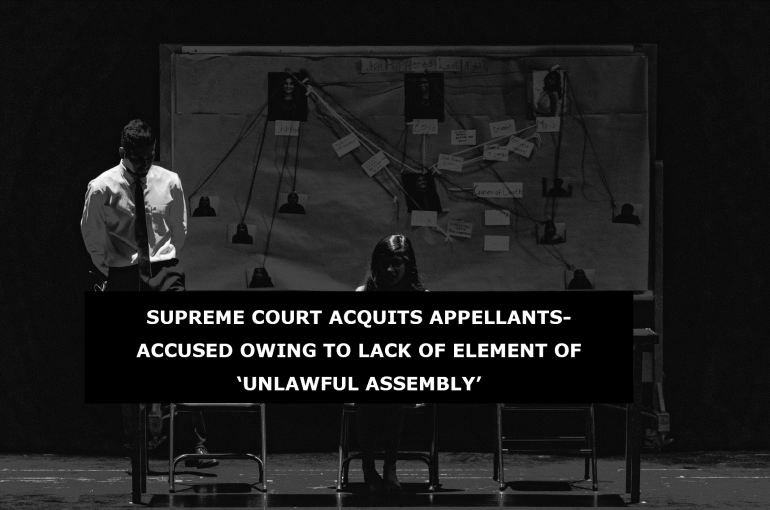SUPREME COURT ACQUITS APPELLANTS-ACCUSED OWING TO LACK OF ELEMENT OF ‘UNLAWFUL ASSEMBLY’
A two Judge Bench of the Supreme Court comprising of Justice Abhay S. Oka and Justice Ujjal Bhuyan passed a judgement dated 07.02.2024 in Kishore and Ors. v. State of Punjab, Criminal Appeal No. 1465 of 2011, wherein the Apex Court held that due to the acquittal of two out of three Accused by the High Court, the requirement of an ‘unlawful assembly’ could not be established under Section 148 of the Indian Penal Code, 1860 (IPC) (Rioting, armed with deadly weapon).
FACTS
The case at hand involves the Appellants, namely Kishore, Bala, and Banaras, along with two other Accused, who faced trial for multiple offences under IPC. They were charged under Section 148 of the IPC (Rioting, armed with deadly weapon), Section 149 IPC (Every member of unlawful assembly guilty of offence committed in prosecution of common object), Section 460 IPC (All persons jointly concerned in lurking house-trespass or house-breaking by night punishable where death or grievous hurt caused by one of them) and Section 302 IPC (Punishment for Murder). All five Accused were convicted by Ld. the Additional Sessions Judge, Patiala in SC No.32/T dated 20.02.2004 (Trial Court).
Following their conviction, the Accused chose to Appeal their case before the High Court of Punjab and Haryana at Chandigarh in Criminal Appeal No. 197-DB of 2009. In the judgment delivered on 27.04.2010, the High Court acquitted two of the Accused, Raka and Lakhan, but upheld the conviction of the present Appellants, Kishore, Bala, and Banaras.
The Prosecution’s case revolves around the events that transpired on the night of 03-07-2003 and 04-07-2003. According to the Complainant, Khushbir Singh (PW-8), he was asleep in his parents’ bedroom along with them. His brother, Satbir Singh and sister-in-law, Narinder Kaur (PW-9) were in another room, while their daughters were in a separate room. PW-8 was awakened by the cries of his nieces and subsequently witnessed four to five individuals entering their house. These intruders assaulted PW-8, PW-9, and Satbir Singh, and proceeded to break open the locks of the almirah, stealing ornaments and cash. During this ordeal, Pratap Singh and Gurpal Kaur, PW-8’s parents, were also assaulted and sustained fatal injuries, leading to their demise in the hospital.
As the Appellants were convicted for the above-mentioned offences, they approached the Supreme Court taking the defense that the PW-8 and PW-9 did not know the Accused persons and the Test Identification Parade (TIP) was not conducted. Moreover, the witnesses have not stated that they have seen the Accused assaulting the Deceased i.e. Pratap Singh and Gurpal Kaur. In order to hold the Appellants liable under Section 148 IPC, there must be at least 5 persons. Thus, the Apex Court held that in the present case, the offences alleged against the Appellants did not fall under the purview of Section 148.
HIGH COURT
THE High Court acquitted Accused no.1, Raka, and Accused no.4, Lakhan, while confirming the conviction of the present Appellants. This indicates that the High Court carefully reviewed the evidence against each Accused individually and reached separate conclusions based on their respective involvement in the case.
SUPREME COURT
Aggrieved by the Order dated 27.04.2010 of the High Court, the Respondent filed Criminal Appeal No. 1465 of 2011 before the Hon’ble Supreme Court, thereby challenging the High Court Order that confirmed the Trial Court Order that convicted the Appellants.
OBSERVATION
The observations made by the Supreme Court in this case are as follows:
1) The Apex Court observed that as the Appellants had already served sentences exceeding seven years, they were granted bail until the Appeal’s disposal. Further, it was highlighted that for an offence under Section 148 of IPC to be established, there must be an unlawful assembly involving five or more persons. As two out of the five Accused were acquitted, there was no unlawful assembly, thus invalidating the convictions under Section 148 IPC.
2) The Apex Court emphasized that while a test identification parade is not mandatory, it can strengthen the Prosecution’s case, especially when eyewitnesses are unfamiliar with the Accused.
3) The Bench scrutinized the testimonies of the witnesses, finding them vague and lacking crucial details. It was noted that without clear evidence linking the Accused to the injuries sustained by the Deceased or doubts regarding the identification of stolen ornaments, the convictions could not be upheld.
4) The Apex Court pointed out the absence of specific roles attributed to the Accused in the offence punishable under Section 460 of the IPC. Additionally, all Accused had been convicted solely based on Section 149 of IPC, which necessitates the existence of an unlawful assembly.
5) Considering the acquittal of two Accused and the failure to establish an unlawful assembly, the Supreme Court concluded that the convictions could not be sustained. Therefore, the Appeal was allowed, and the Appellants were acquitted of all charges. Their bail bonds were cancelled by the Apex Court.
CONCLUSION
Based on the abovementioned facts, the Supreme Court allowed the Appeal and acquitted the Appellants of all charges. The Apex Court observed that the convictions could not be sustained due to the absence of an unlawful assembly, as two of the Accused had been acquitted, and there were doubts regarding the testimonies of the witnesses and the identification of stolen ornaments. Consequently, the bail bonds of the Appellants were cancelled. As a result, the High Court Order dated 27.04.2010 that confirmed the Trial Court Order of conviction of the Appellants was set aside.
Arjav Jain
Legal Associate
The Indian Lawyer





































Leave a Reply